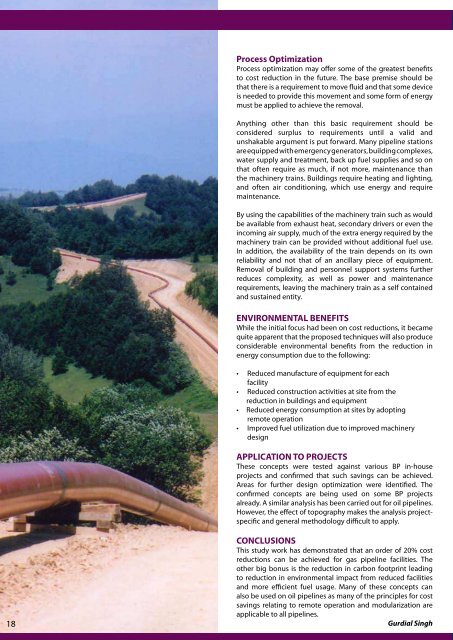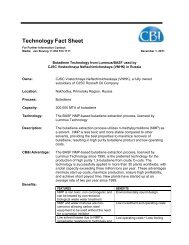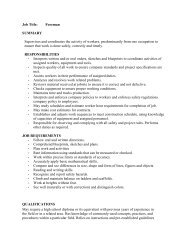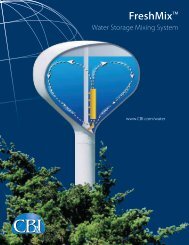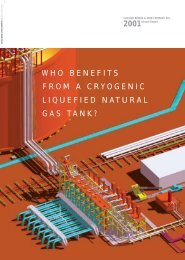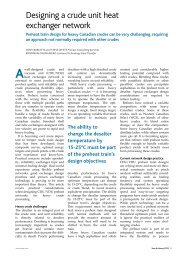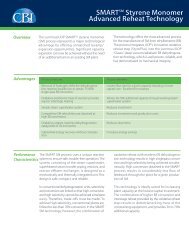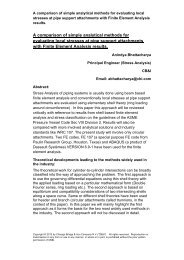Download - CB&I
Download - CB&I
Download - CB&I
Create successful ePaper yourself
Turn your PDF publications into a flip-book with our unique Google optimized e-Paper software.
Process Optimization<br />
Process optimization may offer some of the greatest benefits<br />
to cost reduction in the future. The base premise should be<br />
that there is a requirement to move fluid and that some device<br />
is needed to provide this movement and some form of energy<br />
must be applied to achieve the removal.<br />
Multi-language CB&I Web Site<br />
Marketing News<br />
Tradeshows<br />
Anything other than this basic requirement should be<br />
considered surplus to requirements until a valid and<br />
unshakable argument is put forward. Many pipeline stations<br />
are equipped with emergency generators, building complexes,<br />
water supply and treatment, back up fuel supplies and so on<br />
that often require as much, if not more, maintenance than<br />
the machinery trains. Buildings require heating and lighting,<br />
and often air conditioning, which use energy and require<br />
maintenance.<br />
According to recent demographic data, while English remains<br />
the world’s most popular language, it is the native language of<br />
only around 35% of the global Internet population. In fact, it<br />
is projected than in the near future, 60% of Internet users will<br />
speak a language other than English. To ensure we continue<br />
to provide valuable information about CB&I to our potential<br />
customers – many of whom speak different languages – CB&I’s<br />
Web site, www.CBI.com, is now available online in Russian and<br />
Chinese. Arabic and Spanish versions are coming soon.<br />
We will demonstrate our experience, technology and track<br />
record at a number of forthcoming global trade shows in<br />
2006:<br />
• Global Petroleum Show 2006, 13-15 June 2006,<br />
Calgary, Alberta, Canada<br />
• Power-Gen International, 28-30 Nov 2006, Orlando,<br />
Florida, USA<br />
• GASTECH 2006, 4-6 Dec 2006, Abu Dhabi, UAE<br />
18<br />
By using the capabilities of the machinery train such as would<br />
be available from exhaust heat, secondary drivers or even the<br />
incoming air supply, much of the extra energy required by the<br />
machinery train can be provided without additional fuel use.<br />
In addition, the availability of the train depends on its own<br />
reliability and not that of an ancillary piece of equipment.<br />
Removal of building and personnel support systems further<br />
reduces complexity, as well as power and maintenance<br />
requirements, leaving the machinery train as a self contained<br />
and sustained entity.<br />
ENVIRONMENTAL BENEFITS<br />
While the initial focus had been on cost reductions, it became<br />
quite apparent that the proposed techniques will also produce<br />
considerable environmental benefits from the reduction in<br />
energy consumption due to the following:<br />
• Reduced manufacture of equipment for each<br />
facility<br />
• Reduced construction activities at site from the<br />
reduction in buildings and equipment<br />
• Reduced energy consumption at sites by adopting<br />
remote operation<br />
• Improved fuel utilization due to improved machinery<br />
design<br />
APPLICATION TO PROJECTS<br />
These concepts were tested against various BP in-house<br />
projects and confirmed that such savings can be achieved.<br />
Areas for further design optimization were identified. The<br />
confirmed concepts are being used on some BP projects<br />
already. A similar analysis has been carried out for oil pipelines.<br />
However, the effect of topography makes the analysis projectspecific<br />
and general methodology difficult to apply.<br />
CONCLUSIONS<br />
This study work has demonstrated that an order of 20% cost<br />
reductions can be achieved for gas pipeline facilities. The<br />
other big bonus is the reduction in carbon footprint leading<br />
to reduction in environmental impact from reduced facilities<br />
and more efficient fuel usage. Many of these concepts can<br />
also be used on oil pipelines as many of the principles for cost<br />
savings relating to remote operation and modularization are<br />
applicable to all pipelines.<br />
Gurdial Singh<br />
Hydrogen Plant Technology<br />
Video<br />
In April 2006, CB&I introduced a new video on hydrogen plant<br />
technology. The video utilizes three-dimensional computer<br />
animation to depict CB&I’s hydrogen plant capabilities and<br />
EPC services. It integrates animated images, photos and<br />
other graphics to describe the features and benefits of using<br />
hydrogen plant technology, as well as CB&I’s experience in<br />
designing and building these plants. The new video is available<br />
on CD-ROM, runs six minutes and is playable on any computer<br />
system.<br />
Hot Off the Press ….<br />
“Sulfur Review and Major Projects Review”, Hydrocarbon<br />
Engineering, April 2006. CB&I recently contributed to<br />
Hydrocarbon Engineering’s comprehensive overview of<br />
the key sulfur technologies available to plant/refinery<br />
operators. The section dedicated to CB&I spotlights our<br />
proprietary sulfur recovery unit (SRU) technologies, our<br />
oxygen enhancement technologies, our family of Resulf<br />
tail gas treating unit (TGTU) technology, and the various<br />
construction options we offer for SRU and TGTU projects.<br />
“Coke Drum Design: Reliability Through Innovation”,<br />
White Paper for the NPRA Annual Meeting, March 2006.<br />
The paper examines the theories behind coke drum failure<br />
and demonstrates ways of improving their reliability such as<br />
installing CB&I’s vertical plate technology, which eliminates<br />
the circumferential weld seams in the area prone to distortion<br />
and cracking. In addition, the paper includes a description<br />
of the new skirt attachments that have been developed for<br />
coke drums, as well as an economic case for implementing the<br />
vertical plate design. This paper also will be featured in the 3Q<br />
2006 edition of Petroleum Technology Quarterly.<br />
“Operation Hydrogen”, Hydrocarbon Engineering, February<br />
2006. The article examines steam methane reforming (SMR)<br />
based hydrogen plants and the design nuances that are<br />
now typically a part of designing a modern hydrogen plant.<br />
Factors to consider include the capability to handle multiple<br />
feedstocks, setting an export steam amount that will fit within<br />
a refinery’s steam balance, and controlling the export steam<br />
purity.<br />
19


